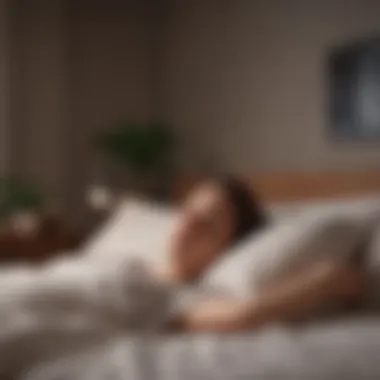Expert Techniques for Speedy Sleep Enhancement


Intro
Sleep is essential for physical and mental well-being. However, many individuals struggle to fall asleep quickly. The reasons can be complex and varied, including stress, anxiety, and a chaotic environment. This article explores techniques that promote faster sleep, addressing these common issues. By utilizing effective strategies, one can establish a pre-sleep routine that maximizes relaxation and minimizes disturbances. Let’s explore these techniques in detail.
Benefits of Guided Meditation
Guided meditation is a powerful tool for enhancing sleep. It offers several benefits that can aid in the process of falling asleep faster, and these advantages stem from both physiological and psychological factors.
Enhancing Mindfulness
Guided meditation fosters mindfulness, which is the practice of being fully present in the moment. By focusing on breathing and calming the mind, individuals can create a mental space that fosters relaxation. This mental clarity can help block out distracting thoughts. With techniques such as body scanning and deep breathing, one can connect better with their physical state, promoting a sense of well-being that is crucial for sleep.
Reducing Anxiety
Moreover, guided meditation plays a significant role in reducing anxiety. When anxiety levels decrease, so does the body's natural fight-or-flight response. Techniques like visualization and affirmation can contribute to this process. By redirecting thoughts from stressors to calming imagery, one can prepare the mind for restful sleep.
"Meditation allows individuals to observe their thoughts without judgment, leading to a more peaceful mind at bedtime."
Importance of Sleep Hygiene
Integrating guided meditation into a larger sleep hygiene practice can amplify its effects. Sleep hygiene encompasses all the habits and practices that help improve sleep quality. Key components include:
- A consistent sleep schedule
- A comfortable sleeping environment
- Limiting screen time before bed
Improving these aspects can enhance the overall effectiveness of guided meditation, leading to a more restful night.
Types of Guided Meditations
There are various types of guided meditations suited for different times of the day. Each type can contribute to a better nighttime routine.
Morning Meditations
Morning meditations can set a positive tone for the day. They help to center the mind, improve focus, and reduce overall stress. This preparation during the day can mitigate feelings of anxiety that may arise later, creating a more relaxed state when approaching bedtime.
Evening Relaxation
Evening relaxation techniques are specifically designed to promote sleep. These sessions often include soothing sounds, gentle guidance, and focused breathing. Individuals can immerse themselves in calming narratives that slow the heartbeat and ease muscle tension, facilitating a smoother transition into sleep.
The End
Incorporating guided meditation, along with improved sleep hygiene, can provide significant benefits for those seeking to fall asleep faster. By addressing both the mind and body, individuals can craft a peaceful environment conducive to rest. By understanding different meditation practices and their effects, anyone can find their path to quicker, more restful sleep.
Understanding Sleep Mechanisms
The comprehension of sleep mechanisms is crucial for anyone striving to enhance their quality of sleep. Without understanding how sleep functions, it can be challenging to identify the effective techniques to fall asleep quickly. Sleep is not merely a state of rest; it is a complex process involving various biological rhythms and cycles. By grasping these mechanisms, individuals can take active steps to improve their nighttime routines and overall wellness.
The Sleep Cycle Explained
The sleep cycle consists of several stages that occur repeatedly throughout the night, generally lasting about 90 minutes each. These stages alternate between Non-REM (NREM) and REM sleep. NREM sleep includes three stages, during which the body begins to relax significantly, heart rates slow, and brain waves decrease.
- Stage 1: This is the lightest phase of sleep, lasting only a few minutes. It is a transition between wakefulness and sleep.
- Stage 2: Characterized by deeper relaxation, the body temperature drops, and brain waves slow with specific bursts of activity.
- Stage 3: Also known as slow-wave sleep, this is the restorative phase, crucial for physical recovery and growth, where the body repairs tissues.
After NREM, the body enters REM sleep, where dreaming frequently occurs, and brain activity resembles wakefulness. Understanding these stages aids in recognizing how important they are for mental and physical health.
Stages of Sleep and Their Importance
The stages of sleep serve unique roles in maintaining health and well-being. Slow-wave sleep (Stage 3) is especially vital. Research indicates that this stage solidifies memories and enhances learning. Furthermore, it boosts the immune system and supports body growth and repair processes.


Conversely, REM sleep is essential for emotional regulation and cognitive functioning. Lack of adequate REM sleep can lead to mood disorders and reduced cognitive abilities. Thus, not only the quantity but also the quality of sleep plays a crucial role in overall health.
How Circadian Rhythms Affect Sleep
Circadian rhythms are natural, internal processes that follow a roughly 24-hour cycle. They regulate sleep-wake patterns, influencing when one feels alert or sleepy. Factors like sunlight exposure can significantly impact these rhythms. Disruptions, such as irregular work hours or excessive screen time before bed, can lead to misalignment, making it difficult to fall asleep swiftly.
A well-synchronized circadian rhythm enables better sleep quality and faster onset of sleep. To support these rhythms, it is recommended to keep a consistent sleep schedule, minimize bright light exposure in the evening, and leverage natural light during the day. By aligning lifestyle choices with circadian rhythms, individuals can support their natural sleep mechanisms.
"Understanding the mechanisms of sleep is essential for improving sleep quality and finding ways to fall asleep faster."
In summary, recognizing sleep mechanisms lays the foundation for effective sleep strategies. Each aspect of sleep, from its cycles to the supporting rhythms, shows how interconnected health and performance are with the quality of sleep one experiences.
Psychological Techniques for Quick Sleep
Psychological techniques for quick sleep play a vital role in achieving restful slumber. They address the mental barriers that often prevent individuals from falling asleep quickly. This section focuses on practical approaches to help reduce stress, anxiety, and racing thoughts that commonly plague those seeking rapid sleep onset. Understanding and implementing these techniques can lead to significant benefits, including faster sleep initiation and improved overall sleep quality.
Cognitive Behavioral Approaches
Cognitive Behavioral Therapy (CBT) is a well-established method for addressing sleep issues. It delves into identifying negative thought patterns that disrupt sleep. When individuals become aware of their unhelpful beliefs and behaviors regarding sleep, they can work to change them. This may involve recognizing distorted messages about not being able to sleep or assuming that sleep loss will lead to severe consequences. By reframing these thoughts, individuals can cultivate a healthier relationship with sleep.
The use of structured exercises is also a key component. Keeping a sleep diary can help track patterns, identify triggers for insomnia, and reinforce positive behaviors. Other CBT techniques include establishing a strict sleep schedule, limiting time in bed while awake, and progressively increasing time spent in bed for successful sleep. Best of all, these approaches rely on empowering individuals, providing them tools to combat the mental restrictions that often stand in the way of achieving quality rest.
Mindfulness and Relaxation Techniques
Mindfulness and relaxation exercises can create optimal mental conditions for sleep. These techniques involve training the mind to focus on the present moment instead of ruminating over the day’s stressors or worrying about the future. Practicing mindfulness can calm racing thoughts, allowing the body to drift into sleep more easily.
Popular practices include meditation and deep breathing exercises. Meditation encourages a state of calmness and self-awareness. In fact, studies suggest that even brief sessions of meditation can lead to reduced sleep onset latency.
Breathing exercises, such as the 4-7-8 technique, also foster relaxation. Here’s how to do it:
- Inhale through your nose for 4 seconds.
- Hold your breath for 7 seconds.
- Exhale completely through your mouth for 8 seconds.
This practice not only calms the mind but also lowers heart rate and promotes relaxation.
Managing Sleep Anxiety
Sleep anxiety, the fear of not being able to fall asleep, often perpetuates insomnia. Understanding this phenomenon is crucial for those wanting to achieve faster sleep. As individuals become anxious about falling asleep, the cycle worsens, creating a self-fulfilling prophecy. Addressing this anxiety involves cognitive strategies that can effectively change perception and reduce negative associations with the act of sleeping.
To combat sleep anxiety, individuals must first acknowledge their feelings and challenge the fears. This could be achieved through journaling thoughts before bedtime or talking to a friend. Practicing mindfulness and relaxation techniques, as mentioned previously, also helps in calming the mind and preventing anxious thoughts from taking over.
Developing a positive pre-sleep routine is another strategy. Engaging in calming activities, such as reading or listening to soft music, can significantly decrease anxiety levels and signal to the body that it is time to wind down.
"Sleep is essential for health, but anxiety about it can create a vicious cycle. Managing sleep anxiety breaks this cycle and paves the way for better sleep."
By integrating these psychological techniques, individuals can cultivate a more tranquil mindset conducive to quick sleep, ultimately enhancing their overall quality of life.
Physical Strategies to Promote Sleep
Physical strategies are crucial for achieving faster sleep. Unlike purely psychological methods, these strategies target the body's physiological state. They focus on creating conditions that make sleep more attainable. The benefits include reducing the time it takes to fall asleep, enhancing sleep quality, and decreasing anxiety levels. Additionally, understanding and implementing physical strategies provide a practical approach for individuals of all ages seeking relief from sleep disruptions.
Breathing Exercises for Relaxation
Breathing exercises serve as a vital tool to induce relaxation before sleep. Controlled breathing techniques can help calm the nervous system. A popular method is the 4-7-8 technique:
- Inhale through your nose for 4 seconds.
- Hold your breath for 7 seconds.
- Exhale slowly through your mouth for 8 seconds.
This method not only slows the heart rate but also lowers blood pressure. Practicing such exercises before bed can significantly enhance the transition to sleep. They help clear the mind and release tension in the body.
Progressive Muscle Relaxation


Progressive muscle relaxation (PMR) is another effective strategy. This technique requires tensing and relaxing each muscle group in the body. Starting from the toes and moving upwards, it encourages a state of awareness and physical relaxation. The process can be structured as follows:
- Tense each muscle group for about 5 seconds.
- Release and notice the feeling of relaxation.
- Move progressively to the next muscle group.
Incorporating PMR into a pre-sleep routine can significantly reduce physical stress and promote quicker sleep onset. This systematic approach can help detoxify the body's tensions and create a state conducive to sleep.
The Role of Physical Activity
Regular physical activity plays a significant role in sleep health. Engaging in moderate exercises can help people fall asleep faster and deepen sleep quality. Aerobic exercises, such as walking or cycling, are particularly beneficial. Here are a few points to consider:
- Aim for at least 150 minutes of moderate exercise weekly.
- Timing matters; working out too close to bedtime may energize rather than relax. It is generally beneficial to exercise in the morning or at least three hours before sleeping.
- Activities like yoga or stretching can promote relaxation and decrease sleep disturbances.
Understanding the impact of physical activity allows individuals to tailor their routines. This guarantees that they not only benefit from exercise but also improve their sleep patterns.
Creating a Sleep-Conducive Environment
Creating a sleep-conducive environment is an essential aspect of optimizing sleep quality. The ambiance of your bedroom plays a pivotal role in signaling to your body that it is time to unwind. The right conditions can ease the transition into sleep and help mitigate disturbances that disrupt rest. Factors such as temperature, bedding, and decor contribute significantly to the overall suitability of your sleep space.
Optimal Bedroom Conditions
The first step is to establish optimal bedroom conditions. Aim for a cool environment, generally between 60 to 67 degrees Fahrenheit (15 to 19 degrees Celsius) is considered ideal. Keeping the room cool can facilitate the body's natural drop in temperature as part of the sleep process.
Bedding is another core element. Ensure your mattress provides appropriate support, as this affects alignment and comfort. Pillows should also be chosen carefully to suit your sleeping position. When the right comfort level is achieved, it can significantly reduce the time it takes to drift off.
A clutter-free environment promotes calm. Too much visual stimulation or disorganization can lead to restlessness. Think about incorporating calming colors, like soft blues or greens, which some studies suggest may help promote relaxation.
Light and Sound Management
Light plays a crucial role in sleep quality and management. Exposure to natural light during the day helps regulate circadian rhythms, while controlling artificial light at night is equally important. Darkening shades or blackout curtains can prevent light from interfering with sleep onset.
Likewise, managing sound is vital for a peaceful sleep environment. Noise can act as a significant barrier to sleep. Use white noise machines or earplugs to eliminate disruptive sounds. Additionally, keeping electronic devices away from the sleeping area reduces both light and noise disturbances.
"Creating a tranquil environment is imperative to enhance your capacity to fall asleep quickly."
Both light and sound management techniques emphasize the requirement to personalize your space based on individual preferences for a more tailored sleeping experience. Making these adjustments will contribute to a significant improvement in rest quality, allowing for quicker transitions into sleep.
Sleep Hygiene Practices
Sleep hygiene practices refer to a series of habits and conditions that can significantly enhance one's quality of sleep. By being mindful of these practices, individuals can create an environment and routine conducive to falling asleep quicker and achieving restful sleep.
Importance of Sleep Hygiene: Sleep hygiene is crucial because it directly influences how quickly one can fall asleep and the overall quality of the rest experienced. When you maintain good sleep hygiene, you can minimize disturbances during the night and wake up feeling refreshed. This is especially relevant for those struggling with anxiety, as establishing a calming bedtime routine can alleviate nighttime worries.
Establishing a Consistent Sleep Schedule
A consistent sleep schedule is one of the cornerstones of good sleep hygiene. This involves going to bed and waking up at the same time every day, even on weekends. This regularity reinforces the body's internal clock, making it easier to fall asleep and wake up naturally.
Some strategies to help establish this schedule include:
- Setting a nightly alarm to remind yourself when to begin winding down
- Avoiding naps during the day if they interfere with your nighttime sleep
- Gradually adjusting your current sleep schedule if you need to make changes
The Importance of a Pre-Sleep Routine
Creating a pre-sleep routine can signal to your body that it is time to wind down. Engaging in relaxing activities before bed can greatly enhance your ability to fall asleep quickly. Consider incorporating some of the following activities:
- Reading a book
- Taking a warm bath
- Practicing relaxation techniques like deep breathing
A consistent pre-sleep routine can help you transition from your daily activities to a state of relaxation, ultimately leading to improved sleep quality.
Mindful Consumption Before Sleep


What you consume before bedtime plays an integral role in sleep hygiene. Certain foods and beverages can either promote or hinder sleep. For instance, caffeine and nicotine can disrupt your ability to fall asleep, while foods high in sugar may lead to restless nights.
To promote better sleep, consider the following:
- Aim for a light snack if you're hungry, focusing on foods rich in tryptophan, such as bananas or almonds
- Limit caffeine intake after early afternoon
- Avoid heavy or spicy meals within two hours of bedtime
Remember: Mindfulness around consumption can help alleviate sleep disturbances and improve your overall sleep quality.
Utilizing Technology for Sleep Improvement
In today's fast-paced world, technology plays a significant role in how we manage our sleep. The integration of technology in our sleep routines can offer innovative solutions that promote faster and deeper rest. This section explores the importance of utilizing technology for sleep improvement and how it can mitigate common sleep challenges.
Sleep Tracking Devices
Sleep tracking devices, such as Fitbit or Oura Ring, have become increasingly popular for individuals looking to enhance their sleep quality. These gadgets monitor various parameters during sleep, including heart rate, sleep phases, and movement.
The data collected can provide insights into personal sleep patterns, helping users understand their sleep cycle better. By analyzing this information, individuals can identify sleep disturbances that may be affecting their rest.
Benefits of Sleep Tracking Devices:
- Data-Driven Insights: Users can track their sleep duration and quality over time, facilitating informed decisions about their sleep habits.
- Goal Setting: Many devices allow for personalized sleep goals, encouraging users to aim for adequate rest.
- Sleep Environment Evaluation: Some trackers assess how environmental factors affect sleep, guiding adjustments for better rest.
It is crucial for users to consider the accuracy and battery life of these devices. Some individuals may find wearable devices uncomfortable. Yet, for many, the insights gained justify the minor inconvenience.
Apps and Aids for Better Sleep
Various apps available today are specifically designed to enhance sleep quality through diverse techniques. Applications like Calm or Sleep Cycle utilize methods that encourage relaxation and improved sleep hygiene.
Functionality of Sleep Apps:
- Guided Meditations: Many apps provide meditative practices or soothing sounds, which can significantly aid relaxation before sleep.
- Sleep Soundtracks: The sounds of nature or white noise can mask disruptive environmental sounds, creating a more peaceful sleeping atmosphere.
- Sleep Coaching: Certain apps offer personalized coaching based on tracked sleep data, helping users optimize their pre-sleep routines.
"Using apps can create a structured approach to improve sleep habits, integrating relaxation techniques into daily routines."
When choosing a sleep app, consider factors such as usability, features offered, and compatibility with tracking devices. Finding the right combination of technology can assist in achieving more restful sleep, allowing users to wake up refreshed.
Limitations and Considerations
Understanding the limitations and considerations surrounding sleep practices is crucial for individuals seeking to improve their sleep quality. The complex interplay of factors affecting sleep goes beyond personal routines; acknowledging these nuances can help in identifying the right strategies that resonate with individual circumstances.
One major consideration is recognizing when standard techniques are insufficient. It is important for individuals to evaluate their experiences with sleep. If a particular method, such as mindfulness or breathing exercises, does not yield quick results, one should not be discouraged. Different approaches will work for different people. Variability in personal responses underscores the need to be flexible in trying new strategies until the right fit is found.
Another dimension is the potential existence of underlying health issues. Lack of sleep could be a symptom of more serious conditions. Conditions such as sleep apnea or chronic insomnia often require specialized intervention. Therefore, if sleep problems persist despite trying various techniques, it is wise to seek professional advice. This proactive step is essential to rule out any medical concerns that demand attention.
Moreover, there are instances when certain remedies may lead to undesirable consequences. For example, over-reliance on sleep aids like melatonin can disrupt your natural sleep cycle. Users may find that their bodies become dependent on these substances, leading to a loop of ineffective sleep patterns.
In summary, recognizing the limitations of personal sleep strategies is fundamental.
"Sleep is not just a personal luxury; it is a vital component of health. Take time to understand your sleep needs."
Being mindful of personal health and encouraging open dialogue with healthcare providers can lead to healthier sleep practices. Understand your options, be open to adjustments, and remember, your journey to better sleep may be unique.
Closure: Integrating Strategies for Better Sleep
In exploring the various methods to sleep faster, it becomes evident that a multifaceted approach is essential. The individual strategies discussed throughout the article offer valuable insights into the physiological, psychological, and environmental factors affecting sleep. Integrating these strategies leads to a holistic improvement in sleep quality and overall well-being.
A key component is understanding the synergy of techniques. For instance, establishing a consistent sleep schedule complements sleep hygiene practices. This synergy can amplify the effectiveness of a pre-sleep routine. When relaxation techniques, such as mindfulness or breathing exercises, are incorporated alongside a conducive sleep environment, it can significantly impact one's ability to drift into sleep quickly.
Furthermore, the use of technology can serve to enhance traditional methods. Sleep tracking devices and apps can provide personalized insights. These tools allow individuals to monitor their sleep patterns, making it easier to identify what strategies work best for them.
Another important aspect is recognizing the limitations and understanding when professional help may be necessary. Sleep disorders can severely disrupt the sleep process. Gaining awareness and being proactive about these issues is crucial.
"Combining several sleep strategies undeniably increases the chances of achieving restful sleep, adapting habits to individual needs proves most effective."
Ultimately, the integration of these strategies does not merely address falling asleep quickly but also fosters long-term health benefits. By committing to a comprehensive approach, one not only enhances their ability to sleep quickly but also cultivates a sustainable pattern of restful sleep.







